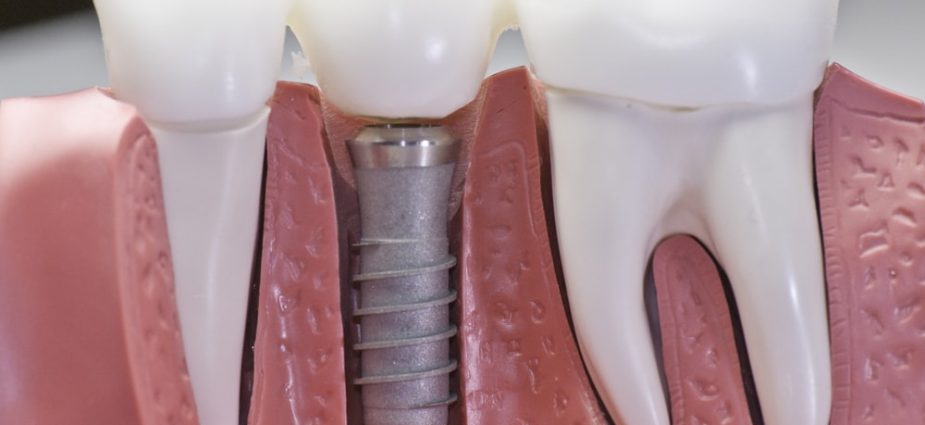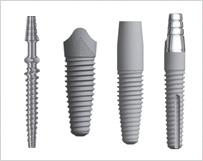Group Family Dentist in Fremont St Stockton Ca
Dental Implants Process & Recovery
Medically Reviewed past: Wayne Sutton, DDS

On this page: Implant consultation | Procedure details | Recovery & Aftercare | Implant types
Dental implants are artificial molar roots used to support a restoration for a missing tooth or teeth, helping to end or forbid jaw bone loss. The implantation procedure is categorized as a grade of prosthetic (artificial replacement) dentistry, but likewise is considered a course of corrective dentistry.
People who have lost teeth might feel too self-conscious to grin or talk. Additionally, biting irregularities caused by molar loss can have a negative effect on eating habits, leading to secondary health problems similar malnutrition.
By replacing missing molar roots, dental implants provide people with the forcefulness and stability required to eat all the foods they love, without struggling to chew. Additionally, they assist to stimulate and maintain jaw os, preventing bone loss and helping to support facial features.
Molar Loss

Teeth are lost because of:
- Tooth decay
- Root canal failure
- Gum disease (Periodontitis)
- Trauma to the mouth (tooth injury)
- Excessive vesture and tear
- Congenital defects
Consultation
To decide if implants are correct for y'all, a consultation with your dentist, oral surgeon, and/or periodontist or prosthodontist is needed. During this engagement, your dental professional will thoroughly examine your teeth and gums and evaluate bone density and quantity. This may involve 10-rays and computer tomography scans (CT scans) to ensure in that location is sufficient bone structure for placing the implant(s), and to determine exactly where they should be placed.
Based on the status of your oral tissues, oral hygiene and personal habits, and commitment to follow aftercare instructions, your dentist will advise you of the nearly advisable treatment program. Some patients with insufficient bone or glue tissue require bone or soft tissue grafts and/or the use of small diameter implants (besides called mini implants).
Depending on your situation, your dental professional will advise you lot of how long the entire handling process volition have, how many appointments will be necessary and what you lot can expect after each procedure. During the consultation, options for local anesthesia (to numb the affected and surrounding areas) and sedation dentistry, if necessary, also will be discussed. The estimated price of your dental implants will also be discussed during this meeting. Costs can vary significantly based on the type of treatment you opt for (amidst other things).
Before Treatment
Any underlying oral health bug must first be managed earlier implantation may be considered. Common issues such as molar decay and gum illness tin can make handling less effective.
If y'all are a smoker, your dentist will propose you lot to quit, as smokers face a greater risk of failure than non-smokers. Smoking tin affect osseointegration, the procedure past which a dental implant anchors to the jaw os.
Once your dentist deems your rima oris healthy enough for handling, your custom treatment can begin.
Placing Your Implant(south) – The Procedure
Today's dental implant restorations are virtually indistinguishable from other teeth. This appearance is aided in part by the structural and functional connection between the implant and the living bone. The process is typically performed in a single sitting only requires a period ofosseointegration.
Osseointegration is the process past which the implant anchors to the jaw bone. An osseointegrated implant takes anywhere from six weeks to six months to anchor and heal, at which point your dentist can complete the procedure by placing a crown, bridge or hybrid denture restoration. If osseointegration does not occur, the implant will neglect.
Dental implantation, which is performed to supersede missing teeth, can be done any fourth dimension later boyhood or when os growth is complete. Sure medical conditions, such as active diabetes, cancer or periodontal affliction, may crave boosted treatment before the procedure tin exist performed.
Detailed procedural steps are as follows:
Preparing the Jaw for Implantation:A dental implant and its restoration is unremarkably equanimous of a titanium material screw and a crown. A small-bore hole (pilot hole) is drilled at edentulous (where there is no molar) jaw sites in order to guide the titanium implant fixture in place. To avoid damaging vital jaw and face structures like the junior alveolar nerve in the mandible (lower jaw), a dentist must use smashing skill and expertise when boring the airplane pilot hole and sizing the jaw os. In many instances dentists employ surgical guides created based on the CT scans when placing the implants.
Placement: After the initial pilot hole has been drilled into the appropriate jaw site, it is slowly widened to let placement of the implant screw. Once in place, surrounding gum tissue is secured over the implant and a protective comprehend screw is placed on top to allow the site to heal and osseointegration to occur. After upward to six months of healing, your dentist will uncover the implant and attach an abutment (which holds the crown or tooth-similar replacement). In some cases, the abutment may be fastened during the initial procedure. When the abutment is in identify, your dentist then will fabricate a temporary or final crown. Sometimes the final crown can be fabricated on the same day that the abutment is placed. The temporary crown serves as a template effectually which the gum grows and shapes itself in a natural way if warranted. The process is completed when the temporary crown is replaced with a final crown.
Recovery, Follow-up & Aftercare
Dental implant recovery depends on a number of factors, one of which includes the various procedures required to consummate your treatment. Still, it is generally recognized that once an implant has been placed, maintaining diligent oral hygiene habits helps ensure proper integration with bone construction. Failure to floss and brush can contribute to failure of the treatment. Infection tin can occur if the implant and surrounding areas are not cleaned properly. Smoking also is attributed to loftier failure rates and should be avoided post-obit implant procedures.
If provisional restorations were placed along with the implant(southward), it will exist important to make clean them as yous would your natural teeth to ensure the best possible healing and fusing.
After the initial surgical process, discomfort should be minimal. Swelling of your gums and face may occur, every bit well equally pocket-size bleeding and bruising of the implant site. Prescription pain medications may be prescribed past your dentist to relieve any pain or discomfort you feel after the procedure. For 5 to seven days subsequently surgery, your diet should exist restricted to soft foods. If stitches are present, they may need to be removed past your dentist; however, self-dissolving stitches that do non require removal are typically used.
Healing from the surgical process to place the implant(s) takes upwardly to six months, while the fitting and seating of the crown(southward) can take up to two months. Over again, this timeframe depends on individual cases and treatments. Follow-upward appointments with your treatment coordinators are essential for monitoring your progress.
If cared for properly, information technology can remain in place for a lifetime.
Types of Dental Implants
More than lx companies manufacturer dental implants and/or the materials used to create the restorations placed on elevation of them. Every bit a result, dentists have many options for identifying the right handling for specific patient needs. However, be aware that if yous undergo an implant procedure past one dentist, so see a different dentist for a repair, your new dentist may have express experience with, or may not have access to, the material components used past the previous dentist.
Dental implants usually are categorized based on the type of procedure used to place them: two-phase or single stage.
Two-Stage Implants: A ii-stage procedure involves surgery to place the implant into the jaw bone and close (sew) the gum tissue. Several months after healing, a minor surgery is performed to attach an abutment and temporary restoration.
Endosteal (Endosseous) Implants: Placed in the jaw bone, endosteals are the most ordinarily used type for two-stage implant procedures. Placed primarily every bit an alternative to a span or removable denture, endosteal implants include screw types (threaded), cylinder types (smoothen) or bladed types.
Single-Stage Dental Implants:A unmarried-stage procedure involves surgically placing a longer implant into the jaw and so it is on the jaw bone, with the top level with the mucilage tissue, later on which the gum tissue is closed (stitched), leaving the implant healing cap visible. As a upshot, afterward several months of healing, the abutment and temporary restoration can be fastened without the demand for minor surgery to expose the head.
Subperiosteal Implants: Placed on the jaw bone within the mucilage tissue, with the metal implant post exposed to hold the restoration, subperiosteals are rarely if e'er used today. Subperiosteals were primarily used to hold dentures in identify in patients with bereft bone summit.
Coatings
Although most dental implants are fabricated of titanium, the surface — which affects the long-term integration and stability of treatment — can vary. A porous surface contributes to more than bone contact than a machined titanium surface. Other surfaces include a dust-blasted or acrid-etched and roughened surface, a microgrooved or plasma-sprayed titanium surface, and a plasma-sprayed hydroxyapatite coating, and Zirconia (nonmetal).
Connectors
Implants also may exist categorized based on the shape/type of their head. All implants crave the restoration and abutment to exist attached or screwed to the caput. For this purpose, there are three primary connector types:
Internal Hex Connectors: Shaped like a hexagon, an internal hex connector is an opening in the implant head into which the restoration/abutment is screwed.
External Hex Connectors: Also shaped like a hexagon, these connectors are atop the implant head.
Internal Octagon Connectors:Shaped like an octagon, an internal octagon connector has an opening in the implant caput into which the restoration/abutment is screwed.
Implant Sizes
Another mode to categorize implants is based on their size (also chosen platform), which dictates where they generally tin be placed in the mouth. However, every example is different, and individual spacing and bone availability needs may dictate the utilise of a different size. The fixture has a platform dimension as well as length, both being of import criteria in fixture selection.
Standard Platform: Standard dental implants range in size from 3.v mm to 4.2 mm in diameter. These comparatively shorter and narrower implants are most unremarkably placed toward the front of the mouth.
Wide Platform: Wide platform dental implants range in size from iv.5 mm to 6 mm in bore and are placed primarily in the dorsum of the mouth.
Mini or Narrow Trunk: Mini or narrow body dental implants range in size from ii mm to three.5 mm in diameter and are placed primarily in patients with insufficient space between their tooth roots to adapt a larger size. They besides may be placed when the patient has insufficient bone density. They are sometimes utilized as temporary support for provisional prostheses while the final conventional dental implants are osseointegrating.
[updated February 5, 2019]
About the Reviewer
Dr. Wayne Sutton is highly experienced cosmetic and reconstructive dentist in private do in Rohnert Park, CA. He received his Doctorate from UCSF School of Dentistry where he also served as a clinical teacher for three years. Dr. Sutton followed up his time at UCSF with extensive post-graduate training in cosmetic dentistry through The Pacific Aesthetic Continuum in San Francisco, one of the world's leading post-grad institutions. He also received training in Advanced Occlusion at the prestigious Hornbrook Group before entering into private exercise. Dr. Sutton became ane of the offset dentists in Northern California to earn his Fellowship in the Academy of Comprehensive Esthetics. He is too a Fellow of the University of General Dentistry, the American University of Implant Dentistry and the Dental Organization for Conscious Sedation. To learn more than about Dr. Sutton, visit his website: SonomaSmiles.com.
hendricksshavessined.blogspot.com
Source: https://www.yourdentistryguide.com/implants/
0 Response to "Group Family Dentist in Fremont St Stockton Ca"
Post a Comment